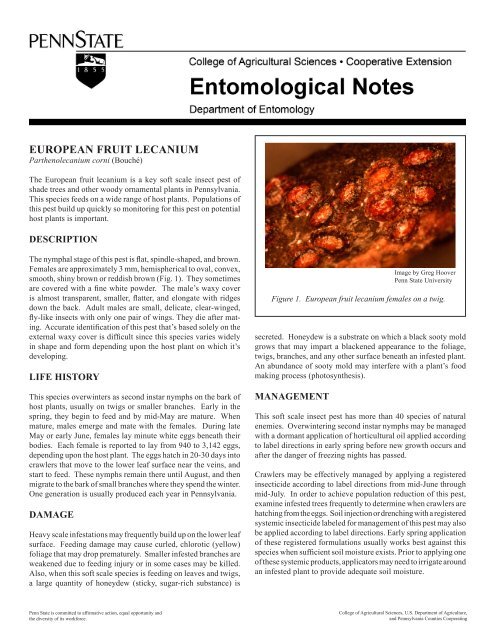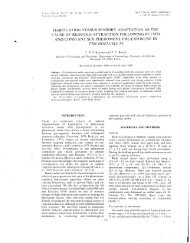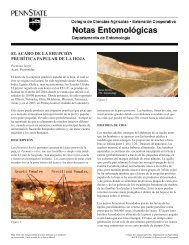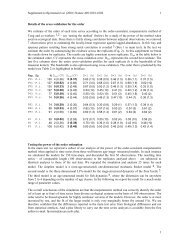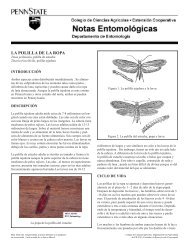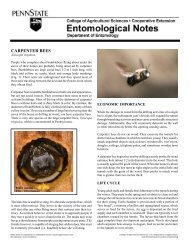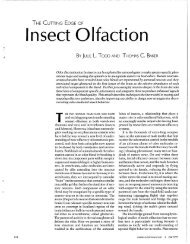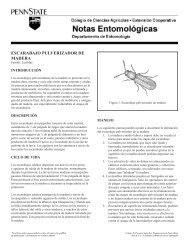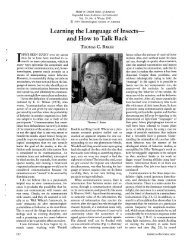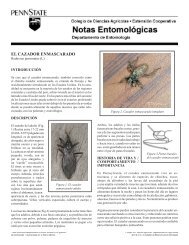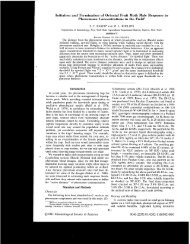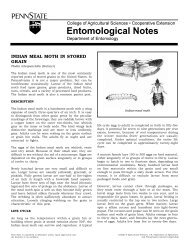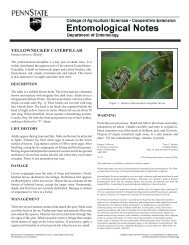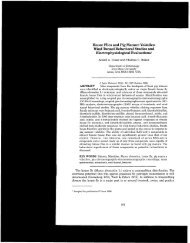PDF version of European Fruit Lecanium Scale Fact Sheet
PDF version of European Fruit Lecanium Scale Fact Sheet
PDF version of European Fruit Lecanium Scale Fact Sheet
Create successful ePaper yourself
Turn your PDF publications into a flip-book with our unique Google optimized e-Paper software.
EUROPEAN FRUIT LECANIUMParthenolecanium corni (Bouché)The <strong>European</strong> fruit lecanium is a key s<strong>of</strong>t scale insect pest <strong>of</strong>shade trees and other woody ornamental plants in Pennsylvania.This species feeds on a wide range <strong>of</strong> host plants. Populations <strong>of</strong>this pest build up quickly so monitoring for this pest on potentialhost plants is important.DescriptionThe nymphal stage <strong>of</strong> this pest is flat, spindle-shaped, and brown.Females are approximately 3 mm, hemispherical to oval, convex,smooth, shiny brown or reddish brown (Fig. 1). They sometimesare covered with a fine white powder. The male’s waxy coveris almost transparent, smaller, flatter, and elongate with ridgesdown the back. Adult males are small, delicate, clear-winged,fly-like insects with only one pair <strong>of</strong> wings. They die after mating.Accurate identification <strong>of</strong> this pest that’s based solely on theexternal waxy cover is difficult since this species varies widelyin shape and form depending upon the host plant on which it’sdeveloping.Life HistoryThis species overwinters as second instar nymphs on the bark <strong>of</strong>host plants, usually on twigs or smaller branches. Early in thespring, they begin to feed and by mid-May are mature. Whenmature, males emerge and mate with the females. During lateMay or early June, females lay minute white eggs beneath theirbodies. Each female is reported to lay from 940 to 3,142 eggs,depending upon the host plant. The eggs hatch in 20-30 days intocrawlers that move to the lower leaf surface near the veins, andstart to feed. These nymphs remain there until August, and thenmigrate to the bark <strong>of</strong> small branches where they spend the winter.One generation is usually produced each year in Pennsylvania.DamageHeavy scale infestations may frequently build up on the lower leafsurface. Feeding damage may cause curled, chlorotic (yellow)foliage that may drop prematurely. Smaller infested branches areweakened due to feeding injury or in some cases may be killed.Also, when this s<strong>of</strong>t scale species is feeding on leaves and twigs,a large quantity <strong>of</strong> honeydew (sticky, sugar-rich substance) issecreted. Honeydew is a substrate on which a black sooty moldgrows that may impart a blackened appearance to the foliage,twigs, branches, and any other surface beneath an infested plant.An abundance <strong>of</strong> sooty mold may interfere with a plant’s foodmaking process (photosynthesis).ManagementImage by Greg HooverPenn State UniversityFigure 1. <strong>European</strong> fruit lecanium females on a twig.This s<strong>of</strong>t scale insect pest has more than 40 species <strong>of</strong> naturalenemies. Overwintering second instar nymphs may be managedwith a dormant application <strong>of</strong> horticultural oil applied accordingto label directions in early spring before new growth occurs andafter the danger <strong>of</strong> freezing nights has passed.Crawlers may be effectively managed by applying a registeredinsecticide according to label directions from mid-June throughmid-July. In order to achieve population reduction <strong>of</strong> this pest,examine infested trees frequently to determine when crawlers arehatching from the eggs. Soil injection or drenching with a registeredsystemic insecticide labeled for management <strong>of</strong> this pest may alsobe applied according to label directions. Early spring application<strong>of</strong> these registered formulations usually works best against thisspecies when sufficient soil moisture exists. Prior to applying one<strong>of</strong> these systemic products, applicators may need to irrigate aroundan infested plant to provide adequate soil moisture.Penn State is committed to affirmative action, equal opportunity andthe diversity <strong>of</strong> its workforce.College <strong>of</strong> Agricultural Sciences, U.S. Department <strong>of</strong> Agriculture,and Pennsylvania Counties Cooperating
WARNINGPesticides are poisonous. Read and follow directions and safetyprecautions on labels. Handle carefully and store in original labeledcontainers out <strong>of</strong> the reach <strong>of</strong> children, pets, and livestock.Dispose <strong>of</strong> empty containers right away, in a safe manner andplace. Do not contaminate forage, streams, or ponds.Gregory A. HooverSr. Extension AssociateDept. <strong>of</strong> EntomologyRevised December 2006TS-15 ©The Pennsylvania State University 2006This publication is available in alternative media on request.Where trade names are used, no discrimination is intended and no endorsement by The PennsylvaniaState University or Pennsylvania Department <strong>of</strong> Agriculture is implied.Entomological Notes are intended to serve as a quick reference guide and should not be usedas a substitute for product label information. Although every attempt is made to produceEntomological Notes that are complete, timely, and accurate, the pesticide user bears theresponsibility <strong>of</strong> consulting the pesticide label and adhering to those directions.Issued in furtherance <strong>of</strong> Cooperative Extension Works, Acts <strong>of</strong> Congress May 8 and June 30,1914, in cooperation with the U.S. Department <strong>of</strong> Agriculture and the Pennsylvania Legislature.D. Jackson, Director <strong>of</strong> Cooperative Extension, The Pennsylvania State University.The Pennsylvania State University is committed to the policy that all persons shall have equalaccess to programs, facilities, admission, and employment without regard to personal characteristicsnot related to ability, performance, or qualifications as determined by University policy orby state or federal authorities. It is the policy <strong>of</strong> the University to maintain an academic and workenvironment free <strong>of</strong> discrimination, including harassment. The Pennsylvania State Universityprohibits discrimination and harassment against any person because <strong>of</strong> age, ancestry, color,disability or handicap, national origin, race, religious creed, sex, sexual orientation, or veteranstatus. Discrimination or harassment against faculty, staff, or students will not be tolerated atThe Pennsylvania State University. Direct all inquiries regarding the nondiscrimination policyto the Affirmative Action Director, The Pennsylvania State University, 328 Bouke Building,University Park, PA 16802-5901, Tel 814-865-4700/V, 814-863-1150/TTY.


